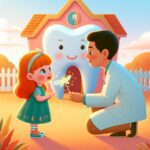Gingivitis, a common dental condition, doesn’t discriminate by age, impacting even the youngest among us. For new parents, understanding gingivitis in babies is crucial for ensuring the health and well-being of their child’s dental hygiene. This article delves into what gingivitis is, its causes, symptoms, preventive measures, and effective treatment options.
What is Gingivitis?
Gingivitis is the initial stage of gum disease, characterized by the inflammation of the gums. It is caused by the accumulation of plaque, a sticky film of food debris, bacteria, and saliva, on the teeth and gums. If left untreated, gingivitis can advance to more severe forms of gum disease, potentially leading to tooth loss and other health complications.
For babies, the risk factors for developing gingivitis include poor oral hygiene, the buildup of plaque due to infrequent cleaning, and certain health conditions. Recognizing the signs of gingivitis early on is key to preventing its progression.
How to Identify Gingivitis in Babies
Identifying gingivitis in babies can be challenging, as they may not be able to communicate their discomfort. However, some common symptoms can signal the presence of this condition. Look out for red, swollen, or bleeding gums, especially during or after brushing. Babies may also show signs of discomfort while feeding or refuse to eat due to the soreness caused by inflamed gums.
Regular dental check-ups are vital for early detection. Pediatric dentists can identify signs of gingivitis and other dental issues before they become severe. Early intervention is crucial for managing gingivitis effectively.
Preventing Gingivitis in Babies
Preventing gingivitis in babies involves establishing a good oral hygiene routine early on. Before your baby’s teeth emerge, gently clean their gums with a soft, damp cloth after feedings. Once teeth appear, use a small, soft-bristled toothbrush to clean their teeth twice a day. Introducing fluoride toothpaste in a rice-grain-sized amount is recommended as soon as the first tooth erupts.
Additionally, avoid practices that can contribute to the buildup of bacteria in your baby’s mouth, such as sharing utensils or cleaning pacifiers with your mouth. Regular dental check-ups, starting from the appearance of the first tooth or by their first birthday, are essential for maintaining your baby’s oral health. For more information on baby’s oral care, consider reading about teething and bottle-feeding practices that can impact dental health.
Treating Gingivitis in Babies
The treatment for gingivitis in babies primarily focuses on eliminating the underlying cause – plaque buildup. This involves improving oral hygiene practices and, if necessary, professional cleaning by a pediatric dentist. In cases of mild gingivitis, enhancing daily oral care routines can reverse the condition and restore gum health.
In more severe cases, your pediatric dentist may recommend additional treatment options. It’s crucial to follow their advice to prevent the progression of gingivitis to more serious gum diseases. For further reading on related conditions, explore topics like baby acne, thrush, and drooling, which can also indicate oral health issues.
For comprehensive guidelines on dental care and preventing gingivitis in children, the American Academy of Pediatric Dentistry (AAPD) offers valuable resources. Following these guidelines can help ensure your baby grows up with a healthy, happy smile.
Understanding and addressing gingivitis in babies is a crucial aspect of parental care. By establishing good oral hygiene habits, being vigilant for symptoms, and seeking timely dental advice, new parents can play a significant role in protecting their baby’s dental health. Remember, early intervention is key to preventing the progression of gingivitis and ensuring your child enjoys a lifetime of healthy smiles.













